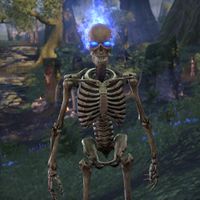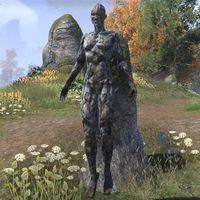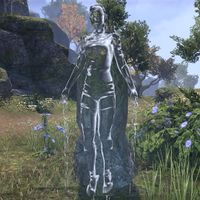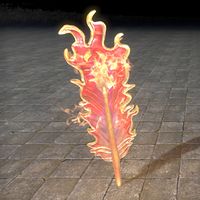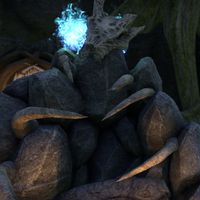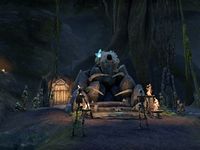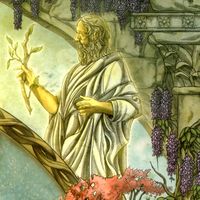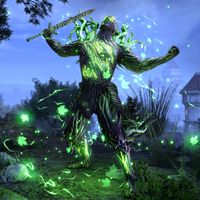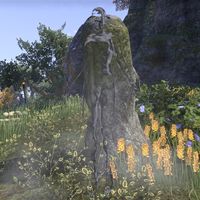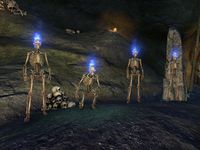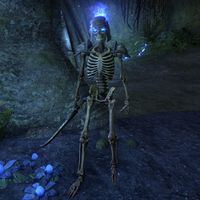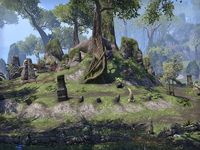Lore:Ehlnofey
The Ehlnofey (sometimes spelled Elhnofey)[1] of the Dawn Era are generally believed to be a group of Aedric pre-Convention spirits who, along with the Hist, are counted among the original inhabitants of Nirn, and are widely considered to be the progenitors of the mortal races.[2][3][4] The word "Ehlnofey" translates to Earthbones (or Earth Bone) in Ehlnofex. The terms "Earthbone" or "Ehlnofey" are used to denote more than one type of mythical entity. The term "Ehlnofey" is typically used to refer to the spirits that became ancestors of the various mortal races, whereas the term "Earthbone" is typically used to refer to those spirits who followed the example of Y'ffre and sacrificed themselves to form the rules of nature. [UOL 1][5] The term "Ehlnofey" is also used to address eventual Earthbones such as Y'ffre during that stage of their existence prior to becoming laws of nature.[UOL 1] The nature of the spirits the term pertains to can vary depending on account.
The concept of the Ehlnofey is of paramount importance within the beliefs of the elves, particularly the Altmer and Bosmer, where the term is used to represent their cultural understanding of the Aedra as ancestor spirits. According to elven myth, the Ehlnofey are considered to be the Aedric spirits who stayed in Nirn after Magnus and the Magna Ge departed in order to keep working on the new world so it'd remain viable. Among those spirits, some, typically referred to from that point on as "Earthbones", are thought to have followed the example of Y'ffre, giving themselves to the Mundus fully to stabilize it and form the foundation of its natural law as the "bones of the earth", eternal laws of nature. While others, typically referred to from that point on as "Ehlnofey", are thought to have chosen not to give themselves fully but to populate Nirn instead, thus becoming the progenitors to mortal life, which arose from their lines and took on its current form due to a phenomenon of gradual diminishment, of each consecutive generation becoming weaker and more removed than its progenitors in stature and might. [2][3][4][6][UOL 1] This understanding forms the basis of the originally elvish term "Aedra" or "ancestor", denoting those spirits which they perceive as being part of their mythic genealogy, including figures such as Auri-El, who most modern Altmer and Bosmer claim direct descent from, Trinimac the "greatest knight of the Ehlnofey", Syrabane and Phynaster.[7][5] Thus elven religious iconography depicts the Ehlnofey as vaguely Elven in shape, but featureless, similar to how they live on in fading memory,[8]
The Aedra or Ehlnofey are thought to have remained within the world until they vanished [9]. They are thought to primarily reside in Aetherius,[10] having been bound to the Earth Bones[11][12][2][5] as the cornerstones of the Mundus.[13] The terms "spokes", "eight components of chaos", "lent bones of the Aedra", "Bones of the Wheel", "et'Ada-gears" and "Eight gift-limbs" have also been used to refer to them in this capacity, after having transformed into the framework of reality.[14][15][16][17] Some sources present a more negative view of the circumstances of these spirits and their residence in Aetherius, naming Mundus as their "cemetery", calling them "spent ghosts", or even alleging them to have died as part of the creation of the world, having "died in pursuit of an impossible goal".[18][19][3] Thus the Aedra are sometimes called the "dead gods" or the "mortal gods", sometimes disparagingly, owing to them having become bound to the laws of mortality.[20][21]
A direct correlation between the concepts of Ehlnofey and Aedra is not universal among sources. In some accounts, the terms "Ehlnofey" and "Earth Bones" are both described as referring exclusively to the early offspring of the Aedra rather than to those spirits themselves, who were told to populate the world and live on through their children, leading to the gradual emergence of the various races of man and mer.[4][UOL 1] In others the Ehlnofey are described instead as a group of beings who predate the Aedra and Daedra as survivors of a prior world, fragment of which Anu used to create Nirn, whereas the Aedra and Daedra are formed of Anu and Padomay's blood after Nirn's formation and the establishment of the Ehlnofey there, with all groups distinct from the start.[6] The concept of descent from the ancestor spirits is generally viewed as "elven conceit" by the religions of Men who, with the exception of the Redguards, view themselves as creations of those spirits rather than their descendants.[6][3][22]
Perhaps because of their association with the land itself, "Old Ehlnofey" became another name for Aldmeris, the mystical homeland of the elves.[7][23] The language or languages of the Ehlnofey became known as Ehlnofex.[3] It has been found that the "Earth Bones", the laws of nature, can be manipulated to some extent.[3][24]
For more information on the Aedra and their role in Tamriel's religions more broadly, see the entry on Aedra.
Origin[edit]
The exact nature of the Ehlnofey is a matter shrouded in much ambiguity, indeed some sources describe them as great beings which once walked Nirn whose true origins none can truly say.[9] There are two major origins that are presented: one that describes the Ehlnofey as survivors of a previous world that settled Nirn after its creation, and another claiming them to be Aedric spirits who were party to Nirn's construction and chose to remain in the world they'd crafted to stabilize it after the departure of Magnus and the Magna-Ge.
Survivors of the Twelve Worlds[edit]
According to the Anuad, when Anu formed Nirn following the shattering of the Twelve Worlds by Padomay, two surviving races originating from what Padomay had sundered were brought to the new world alongside the fragments of their realms which had been used to form it, the Ehlnofey and the Hist.
A group of Ehlnofey, those that would eventually become the progenitors of the Mer, arrived in the new world together alongside a relatively intact fragment of their former home, and attempted to live on as they had before, in their land which would come to be known as Old Ehlnofey. Another group, those who would become the progenitors to Men, were scattered across the new world, and had to wander and find each other over time.
When the wandering Ehlnofey came across Old Ehlnofey, they were overjoyed to find their kin living among the splendor of ages past, but rather than welcoming them the inhabitants of Old Ehlnofey viewed them as degenerates, fallen and corrupted from their experiences in Nirn. In the end and for whatever reason, war broke out between those of Old Ehlnofey, mightier but fewer, and those that wandered, weaker but more numerous and hardened by survival. This destructive war would reshape the face of Nirn, sinking much of the land beneath new oceans, destroying much of the original realm of the Hist and creating the continents of Tamriel, Akavir, Atmora and Yokuda.
The remains of Old Ehlnofey would become Tamriel while the wandering Ehlnofey would scatter to the newly formed continents. Eventually, over time and the passage of generations, the descendants of the two factions of Ehlnofey would gradually give rise to the various groups of Men and Mer. At some point prior to their disappearance, the Ehlnofey are said to have taken on "brilliant students". These students have been theorized to be the Dwemer, who were thus given the sobriquet "Dwarves" by their titanic masters. The events of this tutelage under the Ehlnofey are described in more detail in the full text of the Anuad myth.[25]
While this struggle occurred, the "gods and demons" of the world, the Aedra, Daedra and Magna-Ge would form out of Anu and Padomay's spilled blood, as distinct groups from the Ehlnofey and from each other.[6]
Aedric Progenitors[edit]
According to the Altmeri creation myth, when Magnus departed the Mundus, the et'Ada that took part in its creation broke into groups, most would follow the flight of the God of Magic to become the Magna-Ge, but some of those present chose instead to stay after he departed and keep working on the new world in order to keep it viable.[2][5]
Among those Et'Ada who stayed, some would follow the example of Y'ffre, giving themselves to the Mundus fully to stabilize it and form the foundation of its natural law, and would typically be referred to from that point on as "Earthbones" or "Earth Bones". Others, who would come to be known as Aedra, would choose not to give themselves fully but to populate Nirn instead, having to "make children just to last". This group of spirits would from that point typically be referred to as the "Ehlnofey".[UOL 1] The offspring of the Aedra would exhibit a gradual change however, each consecutive generation was weaker than the one prior, more removed from their progenitors in stature and might.[3]
Through this generational phenomenon of diminishment the offspring of the Ehlnofey would also differentiate, the Ehlnofey too would eventually give away and the first Aldmer would arise, while the "weakest souls" that resulted from it would be formed by Lorkhan into armies he named "Men".[5][3]
Altmeri myth holds that Auri-El and Lorkhan and their respective followers would than war with one another, leading to the shattering of Altmora, the "Elder Wood" and one of the first kingdoms established by Auri-El alongside Old Ehlnofey, at Lorkhan's hands, and culminating in the removal of Lorkhan's Heart following his defeat. During this conflict and prior to Lorkhan's defeat, Auri-El begged Anu to take them back but Anu refused as he'd already created something to replace them. The more merciful Anui-El created Auriel's Bow and Auriel's Shield to be used by Auri-El against Lorkhan's hordes.[3][2][5]
Following the defeat of Lorkhan the Aedra would convene at the Adamantine Tower in order to decide the fate of the new world. Lorkhan's Heart would be removed and the laws and roles of all spirits in the new world would be determined. After this meeting, the Convention, the Aedra would depart the world in their excess for its own sake, as their direct presence rendered both it and the timeless continuity of existence itself unstable.[2][UOL 2][26]
At some point following the events of the war that occurred, the Aldmer, descendants of the Ehlnofey who are described as the strongest of the lesser spirits that remained in the world after Convention, are said to have left their doomed and ruined continent of Aldmeris and colonized southwest Tamriel in the Middle Merethic Era,[2][23] only to spend many centuries fruitlessly searching for their old homeland.[27][UOL 2]
Legacy[edit]
We were the Y'ffre. Then we became the Ehlnofey, the Earth Bones. … "
—Guardian of the Earth
The fracturing of the Aldmer along cultural and racial lines is called the Sundering of Aldmeris, an event during which the Aldmer splintered into the groups that would become the Dwemer (Deep Ones), the Chimer (Changed Ones), the Bosmer (Green or Forest Ones), the Falmer (Snow Ones), the Maormer (Sea or Tropical Ones) of Pyandonea, the Altmer (Elder or High Ones), and the Sinistral Mer (Left-handed Ones) of Yokuda. The progeny of the Wanderers (Wandering Ehlnofey) became the races of men, eventually splitting into many different racial groups, including the Nedes, the Atmorans of Atmora, the Yokudans of Yokuda, and possibly the Tsaesci of Akavir, and other aboriginal groups (Proto-Bretons).[6]
Though the protean race is apparently gone, said by some sources to have faded and vanished after journeying to the lost corners of the world,[9] the Ehlnofey are not entirely forgotten. They are thought to have taken on students before they disappeared, passing their knowledge on to emerging races such as the Dwemer.[25] Knowledge of most individuals has been lost to time, but prominent members still appear in some form in the pantheons of the various races. The Ayleids of Cyrodiil are said to have preserved the Ehlnofey's Dawn Era magics and language to a greater extent than other Mer.[2] The theories of the Dwemer High Craftlord Kagrenac involved using sacred tones on the Heart of Lorkhan and bending the Earth Bones, commanding the "obedience" of the Ehlnofey.[24] According to legend, the Sun Birds of Alinor, a mythical order of Aldmeri explorers from the Merethic Era, managed to pierce the veil between Mundus and Aetherius and journey to the Immortal Plane by using the raw magic of the Ehlnofey.[28]
Nirn is said to be imbued with a wellspring of primordial energy which flows in a network via lines within the ground, described as the manner in which Druids visualize the Earthbones, the laws of nature, places where these "bonelines" intersect are said to possess great power and have an effect on both magic and prayer performed there.[29][30] [31] According to some sources, the reason Nirn is filled with natural caverns is that in primordial times they formed a network that functioned like nodes or capillaries for the divine essence of the Aedra that created it. [32]
The laws that govern Nirn and Mundus and determine the role of all spirits within them, are believed to have been set in place at and through the Adamantine Tower by its creators, defining the roles and nature of the Earthbones within the confines of the "Dragon's timebound tale" and thus the framework of the natural world.[26][UOL 2]
According to some Daedric accounts, Mundus is defined by a degree of malleability which generally doesn't exist within the realms of Oblivion. Whereas Oblivion realms are fundamentally shaped and curated by the will of their creators, Mundus and it's constituent realms submit simultaneously to the ordered influence of the Earthbones and the stubborn caprice of Lorkhan. Thus Mundus is "doughy", things within it can be destroyed, but they never remain gone and instances of them inevitably spring up again.[18]
The earliest martial discipline of Nirn was the "Prismatic Vector Dance of the Ehlnofey", which was recorded and studied by the Demiprince Fa-Nuit-Hen.[33]
Lingering Ehlnofey[edit]
The "Old Bones"[edit]
In the Second Era, what seemed to be lingering Ehlnofey spirits were still present in the Bone Orchard of southern Grahtwood.[34] Originally a group of "Old Bones" that wandered the lands, the travels of these gigantic beings unintentionally caused untold suffering in the lands they'd travel through, making them decide to seek a true death by being completely forgotten since, as long as they were remembered by the world, they could not truly die and leave it.[35] The last of this group, Dringoth, would continue to wander by himself, and so became feared by the Bosmer as a terrible destroyer who would absentmindedly trample their cities and hills under his feet while wandering through, his approach felt through the ground quaking days in advance of his arrival, it is said homes burst and hills turned to slurry under his gait. The fearful Bosmer tricked and magically sealed Dringoth in slumber and, worried the restless remains of the other Old Bones might rise to wander again, brought them to the Bone Orchard, where the magic that ensnared Dringoth would imprison them as well.[9][35][36] As the site became a graveyard and shrine to Y'ffre tended by the Spinners , the Old Bones interred there could not be forgotten and so could not truly die. Some of the Orchard spirits would inhabit elven skeletons to move around, while others preferred to stay resting in their own massive and monstrous appearing bones. The Bone Orchard itself was constructed around the "hill" that was Dringoth's skull, and which the great Barrowbough tree that sealed him was planted on.This group would help foil an attempt by the Worm Cult to reanimate them into an army of giants by possessing the bones of the Bosmer buried in the Orchard and fighting alongside the Vestige, who used the power of a piece of Dringoth's rib to control or destroy the cult's undead, thus preventing the threat their reanimation would have posed to Tamriel. During these events the Orchard Ehlnofey decided on whether to allow Dringoth to keep residing within the Bosmer skeleton he was possessing, or to destroy his vessel and forcibly bind his soul to his own bones so, with his body still sealed by the Barrowbough, he'd never wander again.[37][35][34][38]
The Guardians[edit]
The Beldama Wyrd are a witch coven attuned to nature. They venerate the Breton interpretation of Y'ffre, Jephre.[39] They are guided by elemental spirits known as the Guardians,[40] which are among the extinct Ehlnofey who claim they were once Y'ffre.[41] The Guardians are said to have been present since the dawn of Tamriel[40], nurturing and protecting the land and serving as guides to the Wyrd. They are linked to the Wyrd Tree, a nature spirit older than Men and Mer that takes the form of a gargantuan oak tree that emits an unnatural glow, it gives life to the land and strength to the Wyrd, and conceals secrets from when time began, its roots stretching all across Nirn and touching everything, even the "bones of the world".[42][43][39][44][45][46] The Guardians aided the Vestige in cleansing the corruption of Angof the Gravesinger from the Wyrd Tree, using their power to provide protection from the power of the elemental wraiths called forth by Angof, whose magic would have otherwise been fatal. They repudiated Angof and his Bloodthorn Cult for their pacts with the Daedra, claiming that their deeds "mocked the Aedra, the Ehlnofey" and polluted the land with dark magic.[41][47][48][49]
Other[edit]
Some sources speak of sea-dwelling Ehlnofey with hearts made of pearl residing in old places of primordial energy, rivers and reefs where the Earthbones never quieted down.[29][30]
The Ehlnofey are thought to have taken on students before they disappeared, passing their knowledge on to emerging races. Some theories propose that the use of the term "Dwarves" to refer to the Dwemer originates from ancient times when they were the "brilliant students" of the Ehlnofey with the sobriquet having been given to them by their titanic masters. The events of the Dwemer's tutelage under the Ehlnofey are described in more detail in the full text of the Anuad myth.[25]
Some sources claim that the Dwemer learned much from observing the Ehlnofey, learning how to defy natural laws, the Earthbones, by witnessing Ehlnofey control laws of nature such as that governing decay or the passage between realms. Those same sources claim that the tribe of Aldmer from which the Bosmer eventually originated likewise observed the passing of Y'ffre, who was the first of the Ehlnofey to give of themselves to Mundus fully and become an Earthbone, learning how to defy the Earthbone he established to govern the physical form of things through observing him. It is said that this is the knowledge modern Bosmer invoke to enact a Wild Hunt, reverting to what life truly is beneath Y'ffre's imposed law. The reason for the seemingly undying nature of such Hunt creatures is said to be that in severing themselves from the control of one Earthbone, others also lose their power to impose their own laws on them, thus leading to the Earthbone governing lifespan also losing its power.[UOL 1]
Characteristics[edit]
According to descriptions by seeming Ehlnofey, beings like them can't die and depart from the world unless they are completely forgotten. Fearful that, because of this, the colossal "Old Bones"would rise to wander the lands again, and inflict untold suffering in their wake, the Bosmer used the magic of the Barrowbough to seal them into eternal slumber.[35][34][9]
Bones originally belonging to or possessed by the Ehlnofey are said to glow with great Magicka, despite appearances such remains have no traces of necromancy and even exhibit a degree of resistance to necromantic interference, making it impossible for necromancers to dispel Ehlnofey possession of bodies.[36] Legends surrounding the Bone Orchard describe the beings interred there as having had bodies "made entirely of bone", even while they still wandered the world prior to their confinement by the Bosmer. Indeed the "Old Bones" themselves describe their physical forms during their travels as composed of bone, or as having always been skeletal in nature as far back as they can remember. This might mean being comprised of bone is simply an aspect of their physical form as opposed to their bodies having changed to that state.[9][35][34] Other sources describe aquatic Ehlnofey with hearts made of pearl residing in bodies of water filled with primordial energy.[30]
Ehlnofey spirits have exhibited the ability to possess and reanimate other bodies, and to return and bind souls to their original vessels. Fragments of bone from their bodies possess a power to control or destroy the undead.[37][35][34][38] It is said that the Ehlnofey possess the power to control natural laws such as those governing decay or the passage between realms, and that the Dwemer learned how to defy the hold of such natural laws, the Earthbones, through observing the Ehlnofey.[UOL 1]
The moods of the Ehlofey appear to have an effect on the earth around them. In the Bone Orchard, whenever an Ehlnofey residing within its own bones speaks in anger, the ground will quake in response, and the Old Bone Goradir claims that his mirth upon learning that the Bosmer body Dringoth was possessing had been taken apart shifted the earth of his barrow. The way into the Heart of the Barrowbough could only be opened by Nirenan, one of the Old Bones, who could be invoked through the use of a horn crafted from her own massive tooth.[37][50][34][51][51][52]
The ancient Aldmer incorporated magically potent coral, pearl, and all manner of watery stones in their arcane talismans. Such materials can only be found in places of wild and primordial magic where the Earthbones never quieted down and are collectively termed as "Pearls of the Ehlnofey". Pearls from the Nilumin River in particular are known as "Tears of the Ehlnofey" and were sought by Aldmer divers, who considered them valuable in both healing and enhancing physical and magical ability, incorporating them in both talismans and alchemy. Legend ties the origin of such materials to sea-dwelling Ehlnofey with hearts of pearl, it is theorized that they have a special connection to physical laws, granting them real Aurbic power, and that the Ehlnofey themselves favor them. Whatever the case, Aldmeri talismans incorporating these "Pearls of Ehlnofey" are said to be far more powerful than their modern successors crafted by modern Altmer.[30] Myth claims that Aldmer explorers, the Sunbirds of Alinor, also used such raw Ehlnofic magic to pierce the veil between Mundus and Aetherius and journey to the Immortal Plane.[28]
While slumbering, Ehlnofey are said to be able to dream, the Spinners overseeing the Bone Orchard would tell the Old Bones stories of the Bosmer whose bodies were also buried there to give them something new to dream about.[51]
Some sources describe the Altmer as having the "blood of Ehlnofey", also called the "Old Blood", which is believed to be valuable in Blood Magic.[53]
Behavior and Culture[edit]
The "Old Bones" consider each other distant "family" due to so few of them still remaining within the world.[34] They refer to others as "mortals" and, of those encountered, most view their inability to die as long as they're remembered in a negative manner, describing it as "the doom of endlessness". All but one of these beings are said to have journeyed far to remote places of the world where they could be fully forgotten and so could die, prior to becoming trapped as a result of Dringoth's actions.[35] Indeed Bosmer myth claims that the Ehlnofey generally faded and vanished after journeying to the lost corners of the world,[9]
The language of the Ehlnofey, Ehlnofex, has been described as a dangerous "many-headed" language with characters that constantly distort as one looks at them.[UOL 3][UOL 2] The Ayleids are said to have preserved the Dawn Era magics and runes of the Ehlnofey to a greater extent than other elves, suggesting comparatively greater similarity in their magical tradition.[2]
Cultural Significance[edit]
Altmer view themselves as "true children of the Et'Ada", descendants of the Aldmer and the Ehlnofey, the Aedra or "Divines", that preceded them, in an "unbroken line" dating back to Nirn's creation. This belief was central to the ancestor worship of the Aldmer that eventually gave way to the Altmeri pantheon when the religion shifted from the worship of one's own ancestors to the worship of the ancestors of one's "betters", the most influential in their society. Most Altmer and Bosmer claim direct descent from Auri-El himself. Altmer also count deities like Trinimac, Syrabane and Phynaster among their ancestors. Due to this perceived origin, the Altmer believe that within each of them is housed the "divine spark" and thus they've an obligation to keep an Oghma, an "everscriven scroll" in which they memorialize the events of their lives in honor of their divine ancestors. [54][7][5][3][55][4][56] The Altmer use the eagle both in association with Auri-El, from whom they claim direct descent, himself[57][58], and as a symbol representing the Aedra, their ancestors, who descended from Aetherius and became trapped in physical form by the creation of Nirn, as a whole.[59]. Altmeri prayers reference Auri-El as the Fixed Center of existence who always envelops all people and invoke him to grant his followers stability.[60] Their prayers often emphasize their believed ancestral connection with the Aedra, urging the faithful to give praise to the Divines and thus to their own ancestral lines, and describing the Altmer as always having the gods in their lives. It is said that the body of the divine wills the Altmer into being, and that they are one with the gods, their ancestors, and so should venerate them as one.[61][62]
Bosmer are known to worship Y'ffre. A vital part of the Bosmeri pantheon, Y'ffre's Ehlnofey, or "Earthbones," were created from his corporeal form to establish safety and the laws of nature. These laws took the shape of stories, and there is great debate between tribes competing to interpret Y'ffre's ways and knowledge of the times of chaos, before Y'ffre arrived on the mortal plane.[63] Some legends claim that the Boiche Elves, originating from the Earthbones that followed Jephre, grew the first great Graht-oak the out of the Perchance Acorn, which would become Tower of Green-Sap. Due to the nature of the Acorn being, perchance, elsewhere, many different Green-Saps sprung in many different forms, forming the walking Graht-Oak forests of the Valenwood. Each one told its own stories of the Green, the forest home of the "Boiche-become-Bosmer".[26] Some of the Bosmeri Spinners are connected to the Earthbones, although the exact nature of this connection is unknown.[64] Altmer and Bosmer myth describes how during the Dawn Era, both all life, and even the land itself, were formless and constantly shifted between shapes, until Y'ffre's Naming gave all things in Nirn an enduring form. This event, the establishment of shape, is considered a core element of the Green Pact. In certain circumstances such as the enactment of a Wild Hunt, which is enacted in accordance with what the Pact allows, creatures can be made to "forget their Y'ffre taught shapes", causing the bonds of the Naming to unravel, and return to this original formless state.[65][66][67][68][69] Within Bosmer belief Y'ffre is believed to have created day, night, and the places between through the manner in which he interpreted the laws of time established by Anui-El and applied them to Nirn, he is also believed to be responsible for the movements of the stars, as to this day the realms they're windows to sway and wink to his song.[70] Dunmer faith also acknowledges Y'ffre in this capacity of being the deity responsible for the movements of the stars.[71][39]
Ancient Aldmer were known to utilize magic associated with Ehlnofey in their arcane craftsmanship.[30] According to the legend of the Viridian Sentinel, long ago the Direnni forged a covenant with the Earth Bones to protect their settlements from the wild. The Bretons, who displaced the Direnni, had no such arrangement, and as a result, their farms in Bangkorai were gradually overrun by the wilderness. The people were pushed to the brink of starvation, causing a young boy Greenward to pray to Stendarr for salvation. Stendarr taught him to forge a new pact with the forest, giving him the power to restrain the natural creatures within. He thus became the first Viridian Sentinel.[72]
Reachfolk honor a diverse array of nature spirits, incarnations of nature birthed from the Green, the lifeforce of Nirn's natural world, created in the Dawn Era by the sacrifice of Y'ffre and the Earthbones.[73][74][75][76][77] The spirits honored by the Reachfolk can have distinct characteristics, such as the spirits associated with springs, trees or sacred animals.[78][79] Their shamans occasionally utilize calming spirits that may inhabit their staves.[80] Expressing gratitude to nature spirits, they make it a practice to thank them before felling trees and replace them by planting new ones.[79]
Y'ffre and the Earthbones play a central role in the beliefs of both Druids and Wyrd.[81].The Druids commune with the voices of Y'ffre and the Earthbones for guidance and tap into their power through their magic.[76][82]. The Wyresses believe that during Y'ffre's Naming, the act which gave all life on Nirn its shape,[83] the deity tasked the Earthbones to choose those who would become the guardians of nature,[84] a task ultimately given to the Wyresses, the Name-Daughters, who are descendants of the Ehlnofey themselves.[39]
The "Old Ways" of the Psijic Order are said to combine mysticism, the Eleven Forces and the divine laws that define reality into a philosophy and way of life which boasts a deep understanding of the Ehlnofey, from whose lines the races of Man and Mer arose.[4]
According to the Order of the Ancestor Moth, mortal souls are the Aedric essence at the core of every mortal's existence.[85] Souls have also been described as the piece of every mortal which comes from Aetherius, the realm of pure light and magic, and a "tiny star" which flares into a "sun" when magic is invoked.[86]
The existence and nature of the spirits involved in the creation of Mundus has been subject of commentary by some of the Daedra, though even among them various views exist. The Dremora Lyranth described the Mundus as the "cemetery" of the Aedra, claiming that their original hopes for their mortal descendants, and their world, were ultimately not achieved due to the mortal's foolishness. Nonetheless, though the creators of Mundus are said to have "died in pursuit of an impossible goal", they are praised for their immense conviction and admired for having wrought order out of chaos, a "brutal coercion" which even Daedra must deem impressive. By contrast, Magnus and the Magna-Ge are viewed as cowards, no other spirits being as low, who fled when things turned dire, thus making it impossible to ever know what could've been achieved had they chosen to stay and keep helping to the end.[18] Contrasting Lyranth's view, the Mazken information broker Madam Whim, claimed that no living being existed which could explain the true relationship between the Aedra and the Daedric Princes, and that no information she'd ever come across in her long life indicated the Aedra were anything more than a story mortals told themselves to feel safer in their beds at night.[87]
Gallery[edit]
Notes[edit]
- The war between the Ehlnofey described in The Annotated Anuad bears many striking parallels with the war between Lorkhan and Auriel described in The Monomyth, and the texts are likely summarizing the same events from different historiographical perspectives.
- The Ehlnofex war has been described by some sources as being the same event as Convention told in a different manner.[UOL 1]
- Trinimac has been described as the "greatest knight of the Ehlnofey, champion of the Dragon of Time" in certain Cyrodiilic folktales.[88].[87]
See Also[edit]
- For game-specific information, see the Elder Scrolls Online article.
Books[edit]
- The Annotated Anuad — Early religious book providing a simplified version of The Anuad creation myth from the Mythic Era
- Before the Ages of Man by Aicantar of Shimerene — Chronicles the major events of the Dawn and Merethic Eras
- The Monomyth — A theological book containing the common creation myths
References[edit]
- ^ Pocket Guide to the Empire, 1st Edition: Skyrim — Imperial Geographical Society, 2E 864
- ^ a b c d e f g h i Before the Ages of Man — Aicantar of Shimerene
- ^ a b c d e f g h i j The Monomyth
- ^ a b c d e The Mystery of Artaeum — Penewen, Advisor to the Court
- ^ a b c d e f g Varieties of Faith... — Brother Mikhael Karkuxor of the Imperial College
- ^ a b c d e The Annotated Anuad
- ^ a b c Pocket Guide to the Empire, 3rd Edition: The Blessed Isle: Alinor and the Summersets — Imperial Geographical Society, 3E 432
- ^ Elusive Ehlnofey Statuette
- ^ a b c d e f g Last of the Old Bones
- ^ Serana's dialogue in Skyrim
- ^ Aedra and Daedra
- ^ Tower of Adamant — Hrerm House-builder, Bards College, Solitude
- ^ Pocket Guide to the Empire, 3rd Edition: Arena Supermundus: The Tapestry of Heaven — Imperial Geographical Society, 3E 432
- ^ 36 Lessons of Vivec, Sermon 6 — Vivec
- ^ The Lunar Lorkhan — Fal Droon
- ^ The Truth in Sequence — Deldrise Morvayn, Fourth Tourbillon to the Mainspring Ever-Wound
- ^ Mythic Dawn Commentaries 3 — Mankar Camoran
- ^ a b c Loremaster's Archive - Mehrunes Dagon & Daedra in the Second Era — Lyranth
- ^ Glorious Upheaval — Thendaramur Death-Blossom
- ^ Vastarie's dialogue in ESO
- ^ The Prophet's dialogue in Oblivion
- ^ Tu'whacca, Arkay, Xarxes — Lady Cinnabar of Taneth
- ^ a b Pocket Guide to the Empire, 3rd Edition: All the Eras of Man, A Comprehensive History of our History — Imperial Geographical Society, 3E 432
- ^ a b Baladas Demnevanni's dialogue in Morrowind.
- ^ a b c Pocket Guide to the Empire, 1st Edition: Hammerfell — Imperial Geographical Society, 2E 864
- ^ a b c Aurbic Enigma 4: The Elden Tree — Beredalmo the Signifier
- ^ Father Of The Niben — Florin Jaliil
- ^ a b Prismatic Sunbird Feather antiquity codex entry in ESO
- ^ a b Stormweaver's Cavort codex entries in ESO: Firesong
- ^ a b c d e Pearls of Ehlnofey codex entries in ESO: Markarth
- ^ Visitor's Guide to Y'ffre's Cauldron — Bernardine Gelves, Associate Chancellor of Cultural Heritage
- ^ Weeping Wind Cave loading screen in ESO
- ^ Lord Fa-Nuit-Hen and Tutor Riparius Answer Your Questions 2 — Fa-Nuit-Hen and Tutor Riparius
- ^ a b c d e f g Dringoth's dialogue in ESO
- ^ a b c d e f g Olphras' dialogue in ESO
- ^ a b Bone Orchard Research — Bonelord Ethruin
- ^ a b c Events of Keeper of Bones in ESO
- ^ a b Dringoth's Rib effect in ESO
- ^ a b c d Witch Cults of Northern High Rock — Wafimeles Masteret (Lorekeeper)
- ^ a b Wyress Ileana's dialogue in ESO
- ^ a b Guardian of the Earth's dialogue in ESO
- ^ Wyress Helene's dialogue in ESO
- ^ The Improved Emperor's Guide to Tamriel: High Rock — Flaccus Terentius, 2E 581
- ^ Wyress Jehanne's dialogue in ESO
- ^ Wyrd Tree verse
- ^ Crafting Motif 93: Ancestral Breton Style — Serge Serlyn, "Military Scholar of Much Renown"
- ^ Guardian of the Water's dialogue in ESO
- ^ Guardian of the Air's dialogue in ESO
- ^ Corruption of the Tree's encounter in ESO
- ^ Goradir' dialogue in ESO
- ^ a b c Spinner Amariel's dialogue in ESO
- ^ Nirenan's Horn description in ESO
- ^ Gharakul's Journal in ESO
- ^ The Onus of the Oghma — Phrastus of Elinhir
- ^ A Rejection of Open Borders — Kinlady Avinisse of Shimmerene
- ^ Ayrenn: The Unforeseen Queen — Headmaster Tanion of the College of Aldmeri Propriety
- ^ Driftwood Idol contraband in ESO
- ^ Winged Auri-El contraband in ESO
- ^ Elder Scrolls Online - Knowledge Base
- ^ Coils of the Father
- ^ Praise Be
- ^ Mirnor of Auri-El's dialogue in ESO
- ^ The Improved Emperor's Guide to Tamriel: Valenwood — Flaccus Terentius, 2E 581
- ^ Earthbone Spinner in Legends
- ^ The Ooze: A Fable
- ^ Brief Letter to an Aldarch in ESO
- ^ Wild Hunt Horse mount description in ESO
- ^ Wild Hunt Crate descriptions in ESO
- ^ Varieties of Faith in the Empire — Brother Mikhael Karkuxor of the Imperial College
- ^ Girnalin's dialogue in ESO
- ^ Of Jephre — Anonymous
- ^ The Viridian Sentinel
- ^ Frii's dialogue in ESO
- ^ The Ooze: A Fable
- ^ Psijic Style description in ESO
- ^ a b Druid Audrine's dialogue in ESO
- ^ Druid Laurel's dialogue in ESO
- ^ Great Spirits of the Reach: Volume 2 — Vashu gra-Morga, Chief Daedrotheologist at the University of Gwylim
- ^ a b Malug's dialogue in ESO: Markarth
- ^ Staff of the Spirit Within
- ^ Wyrd and Druid — Archdruid Barnabe's Discourse with Mainlanders, 2E 553
- ^ Legacy of the Bretons — Stefan Mornard
- ^ Wild Hunt Crown Crate season description in ESO
- ^ Wyresses: The Name-Daughters — Glargargil the Speaking Oak
- ^ The Distributed Soul — Abbot Crassius Viria
- ^ pg. 52 Lord of Souls — Greg Keyes
- ^ a b Loremaster's Archive - Malacath and Maelstrom — Madam Whim
- ^ Lord of Souls — Greg Keyes
Note: The following references are considered to be unofficial sources. They are included to round off this article and may not be authoritative or conclusive.
|
|||||||||||||||||||||||||||||||||||||||||||
|
|||||||||||||||||
|
|||||||||||
|
||||||||||||||||||||||||||
|
||||||||||||||||||||||||||||||||||||


